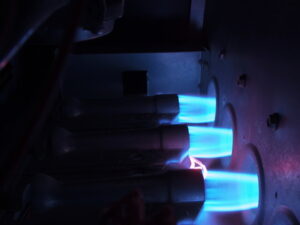
The #1 potential furnace danger for homeowners to be aware of is a cracked heat exchanger. Now, this isn’t to say that furnaces are inherently dangerous, because they’re not. But this is a very important blog post to read if you are using a gas furnace to keep your home warm.
When not properly maintained, a gas furnace, especially one that has aged to about 10-15 years, can become hazardous. The same can be said for any gas-powered appliance, as any one of them has the potential to develop safety problems depending on how they’re cared for.
While your gas furnace does have a special safety feature that turned the system off if something malfunctions internally, a cracked or damaged heat exchanger can be subtle, and insidious. Read on as we explain.
The Role of a Furnace Heat Exchanger
The heat exchanger is the component of your furnace actually responsible for allowing the system to heat up the air that travels through the unit’s ductwork. When the burner jets of the furnace ignite, the combustion gases coming out of them collect inside the heat exchanger, which is a metal chamber or series of chambers that is clamshell-shaped.
The blower fan of your furnace sends air around the heat exchangers, and the air picks up the heat from the furnace wall and continues through the ducts and into your living space. This all allows air through without that air ever making contact with the combustion gases.
Once a heating cycle is complete, the combustion byproducts in the heat exchanger get vented out of the system through a flue, to release them harmlessly into the outdoor air.
What Happens When a Heat Exchanger Cracks
Since the metal of the heat exchangers expand and contract as they heat up and then cool back down, the strain can eventually cause damage to the exchanger in the form of cracks and fissures.
Due to the reaction that occurs between the metal and the combustion gases, corrosion can also weaken the metal until it cracks. These cracks we speak of are usually microscopic in size–basically invisible to the naked eye. But as we mentioned above, the metal of the heat exchanger expands when it heats up, which then allows cracks to open up just wide enough to let gases escape out.
This means that you and your family could potentially be exposed to CO (carbon monoxide) which is a tasteless, odorless, and harmful gas that leads to hundreds of poisoning cases across the country each year.
“So, How Do I Know If I Have a Cracked Heat Exchanger?”
The first thing we want to mention here is regardless of whether or not you suspect you might have a cracked heat exchanger, all homes with gas-powered appliances should have carbon monoxide detectors/alarms installed in them. This allows you an adequate warning if there is too much CO in your home to exit and call your utility company’s emergency service line.
CO leaks and cracked heat exchangers are not obvious, but you can prevent them by staying on top of your annual furnace maintenance appointments, so we can check for them. Additionally, if you hear clicking as your furnace cycles off each time, and you’ve never heard this noise before, it could be the heat exchangers contracting as they cool down and the crack(s) closing–this is a good enough indicator to give our team a call!
For reliable Chambersburg, PA heating services, look no further than Premier HVAC Services! Contact us today.

